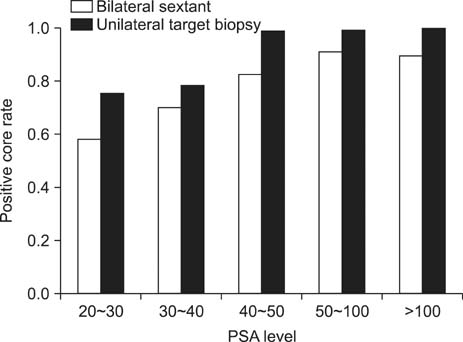World J Mens Health.
2015 Dec;33(3):188-193. 10.5534/wjmh.2015.33.3.188.
The Practicality of Targeted Prostate Biopsy Procedures on the Dominant Side of the Tumor Determined by Magnetic Resonance Imaging in Elderly Patients with High Serum Levels of Prostate-Specific Antigen
- Affiliations
-
- 1Department of Urology, Jeju National University School of Medicine, Jeju, Korea. urology.park@gmail.com
- 2Department of Radiology, Jeju National University School of Medicine, Jeju, Korea.
- KMID: 2405147
- DOI: http://doi.org/10.5534/wjmh.2015.33.3.188
Abstract
- PURPOSE
To examine the possibility of reducing the number of cores per prostate biopsy in elderly patients with high levels of prostate-specific antigen (PSA) without significantly lowering the detection rate of prostate cancer.
MATERIALS AND METHODS
Two hundreds sixteen men with PSA levels >20 ng/mL who underwent prostate biopsies from May 2009 to April 2013 were retrospectively reviewed. With the help of magnetic resonance imaging (MRI), the laterality of the dominant tumor burden in patients was determined. The results of targeted biopsies were compared with those of conventional biopsy procedures.
RESULTS
The mean age and PSA level were 79.5 years and 81.3 ng/mL, respectively, and the overall diagnostic rate of sextant biopsies was 81.9% (177/216). MRI was able to show the tumor burden in 189 of the 216 patients. The detection rate of transrectal ultrasonography (TRUS)-guided targeted biopsies was 87.3% (165/189). Detection rates were comparable with conventional biopsies (81.9% [177/216]) (p=0.23). Of the 177 men in whom the results of the sextant biopsy were positive, 12 men (6.8%) with PSA levels <29 ng/mL did not have any cancer cells according to targeted biopsies. However, all other patients were diagnosed with prostate cancer using the abovementioned techniques.
CONCLUSIONS
We believe that TRUS-guided targeted biopsies of the prostate in elderly men with high PSA levels could reduce the number of unnecessary cores per biopsy. However, a risk of detection loss remains. Therefore, we recommend that at least a sextant biopsy should be performed, even in elderly patients, in order to detect prostate cancer.
MeSH Terms
Figure
Reference
-
1. Gerstenbluth RE, Seftel AD, Hampel N, Oefelein MG, Resnick MI. The accuracy of the increased prostate specific antigen level (greater than or equal to 20 ng./ml.) in predicting prostate cancer: is biopsy always required? J Urol. 2002; 168:1990–1993.2. Anastasiadis A, Zapała L, Cordeiro E, Antoniewicz A, Dimitriadis G, De Reijke T. Complications of prostate biopsy. Expert Rev Anticancer Ther. 2013; 13:829–837.
Article3. Wade J, Rosario DJ, Macefield RC, Avery KN, Salter CE, Goodwin ML, et al. Psychological impact of prostate biopsy: physical symptoms, anxiety, and depression. J Clin Oncol. 2013; 31:4235–4241.
Article4. Isebaert S, Van den Bergh L, Haustermans K, Joniau S, Lerut E, De Wever L, et al. Multiparametric MRI for prostate cancer localization in correlation to whole-mount histopathology. J Magn Reson Imaging. 2013; 37:1392–1401.
Article5. Shigemura K, Yamanaka N, Yamashita M. Can diffusion-weighted magnetic resonance imaging predict a high Gleason score of prostate cancer? Korean J Urol. 2013; 54:234–238.
Article6. Djavan B. Prostate biopsies and the Vienna nomograms. Eur Urol Suppl. 2006; 5:500–510.
Article7. Nomikos M, Mariappan P, Zachou A, McNeill A, Bollina PR. Could prostate biopsies be avoided in men older than 75 years with raised PSA? Urol Int. 2010; 85:410–414.
Article8. Carvalhal GF, Daudi SN, Kan D, Mondo D, Roehl KA, Loeb S, et al. Correlation between serum prostate-specific antigen and cancer volume in prostate glands of different sizes. Urology. 2010; 76:1072–1076.
Article9. Pinkhasov GI, Lin YK, Palmerola R, Smith P, Mahon F, Kaag MG, et al. Complications following prostate needle biopsy requiring hospital admission or emergency department visits - experience from 1000 consecutive cases. BJU Int. 2012; 110:369–374.
Article10. Loeb S, van den Heuvel S, Zhu X, Bangma CH, Schröder FH, Roobol MJ. Infectious complications and hospital admissions after prostate biopsy in a European randomized trial. Eur Urol. 2012; 61:1110–1114.
Article11. Berger AP, Gozzi C, Steiner H, Frauscher F, Varkarakis J, Rogatsch H, et al. Complication rate of transrectal ultrasound guided prostate biopsy: a comparison among 3 protocols with 6, 10 and 15 cores. J Urol. 2004; 171:1478–1480. discussion 1480-1
Article12. Madej A, Wilkosz J, Różański W, Lipiński M. Complication rates after prostate biopsy according to the number of sampled cores. Cent European J Urol. 2012; 65:116–118.13. Moore CM, Robertson NL, Arsanious N, Middleton T, Villers A, Klotz L, et al. Image-guided prostate biopsy using magnetic resonance imaging-derived targets: a systematic review. Eur Urol. 2013; 63:125–140.
Article14. Pokorny MR, de Rooij M, Duncan E, Schröder FH, Parkinson R, Barentsz JO, et al. Prospective study of diagnostic accuracy comparing prostate cancer detection by transrectal ultrasound-guided biopsy versus magnetic resonance (MR) imaging with subsequent MR-guided biopsy in men without previous prostate biopsies. Eur Urol. 2014; 66:22–29.
Article15. Baco E, Rud E, Eri LM, Moen G, Vlatkovic L, Svindland A, et al. A randomized controlled trial to assess and compare the outcomes of two-core prostate biopsy guided by fused magnetic resonance and transrectal ultrasound images and traditional 12-core systematic biopsy. Eur Urol. 2015; DOI: 10.1016/j.eururo.2015.03.341. [Epub].
Article16. Norberg M, Egevad L, Holmberg L, Sparén P, Norlén BJ, Busch C. The sextant protocol for ultrasound-guided core biopsies of the prostate underestimates the presence of cancer. Urology. 1997; 50:562–566.
Article17. Presti JC Jr, O'Dowd GJ, Miller MC, Mattu R, Veltri RW. Extended peripheral zone biopsy schemes increase cancer detection rates and minimize variance in prostate specific antigen and age related cancer rates: results of a community multi-practice study. J Urol. 2003; 169:125–129.
Article
- Full Text Links
- Actions
-
Cited
- CITED
-
- Close
- Share
- Similar articles
-
- How to use new transrectal ultrasound in prostate cancer detection and biopsy for beginners and experts
- Multiparametric MRI in the Detection of Clinically Significant Prostate Cancer
- Comparison of Multiparametric and Biparametric MRI in First Round Cognitive Targeted Prostate Biopsy in Patients with PSA Levels under 10 ng/mL
- Change of serum prostate specific antigen values after radiation therapy in prostate cancer
- Prostate-Specific Antigen Variation as a Predictor of Prostate Cancer in Patients With Prostate-Specific Antigen ≤20 ng/mL Who Underwent Magnetic Resonance Imaging-Targeted Prostate Biopsy


